If you are thinking about how to make rabbit skins at home, you need to know that this requires the appropriate breeds, namely a black-brown rabbit, a white giant, and also chinchilla. The gray giant and other breeds not mentioned above are excellent when they have a thick fur layer. As soon as the molting period ends, you can slaughter the animal. In rabbits, as in some other animals, molting sometimes continues for several months - from November to March. If this process is not yet finished, then you can blow off the hairline, where the undercoat is perfectly visible, and see that the hair in this case is easily pulled out.
Skinning
Before you make rabbit skins at home, you need to remove them. Most often, this process is carried out by stocking. The method is called the “handset”. The carcass is tied on a stick upside down by the legs. It must be freshened with a sharp knife. A small incision is made near the hocks, as well as along the perineum. Then the front paws are cut to the wrist joint, the tail and ears are cut off. The skin should be pulled off with a stocking, directing movements downward, the grip should be done in the thigh area.

Removal must be made from the front paws and head. To do this, make an incision around the eyes, nostrils and mouth. In the process of removing the skin, you do not need to stretch it, since the fur will become thinner from this. Before you make rabbit skins at home, you should learn that this process is quite time-consuming, it assumes that the master has certain knowledge. From the first time it is not always possible to get the desired result. To soften the rabbit skin, you should use the method of pulling, which is especially common among the northern peoples.
Fumigation
Initially, drying is carried out according to a fresh-dry method: a small area is sprayed with milk, and then produce such a movement with your hands that resembles the case when you remove dirt from clothes. Felling is carried out from centimeter to centimeter. In parallel, the film is removed. This will allow you to get a fairly soft skin, however, the process can drag on for a long time and take a lot of energy.
Skinning Technology
Before you make rabbit skins at home, you should familiarize yourself with each step of the process separately. Among them, preparation, dressing and decoration can be distinguished. The first step will be soaking, washing, waxing and degreasing. The master can choose a method depending on his own skills. It is about pickling or pickling.
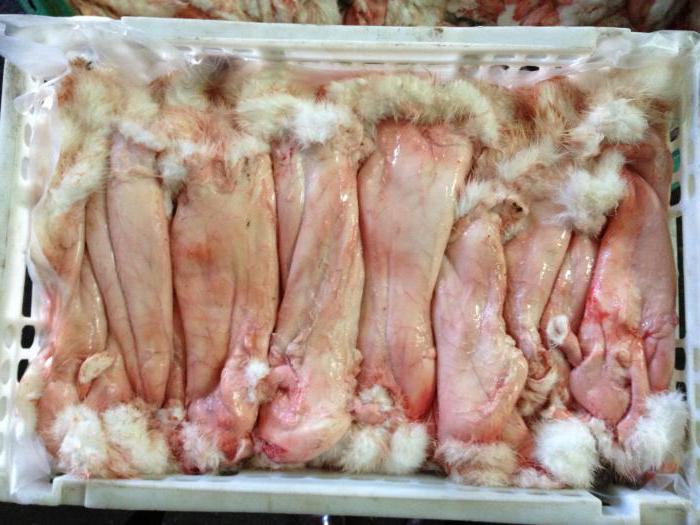
The next step is tanning and fatliquoring. In conclusion, the skins will need to be dried, as well as carry out cosmetic processing of leather fabric.
Dressing
Before dressing rabbit skins at home, tanning should be done according to all the rules. About it will be described below. But soaking can be carried out in solutions and water. After the skin is dried, it should be placed in a prepared dish filled with water. If the blanks were stored for a long time, then they should be left in the liquid for several days. Water needs to be changed regularly.
To help the master
If you decide to do the described procedure, you should know everything about dressing rabbit skins at home. Thus, blanks should be kneaded from time to time. If properly soaked, the material will float freely.It is important to observe the proportions, which in relation to the volume of the skins is 3: 1. This indicates that for 3 liters of water 1 kilogram of skins will be needed.
After the material dries, it will resemble fresh. In order to exclude the occurrence of putrefactive microbes, it is necessary to soak the kitchen antiseptics and salt in a solution using the ratio of 50 grams of salt per 1 liter of water.
The use of antiseptics
If you are faced with the question of how to make rabbit skins at home, the technology you should have studied beforehand. It provides for the use of antiseptics. In this case, the proportion should be observed. Thus, if you have available sodium bisulfate, then it will need 2 grams per 1 liter of water. For the same volume of liquid, one gram of formalin should be used. The amount of water remains the same, but zinc chloride should be used in a volume of 2 grams. As for norsulfazole, then 2 tablets are needed.
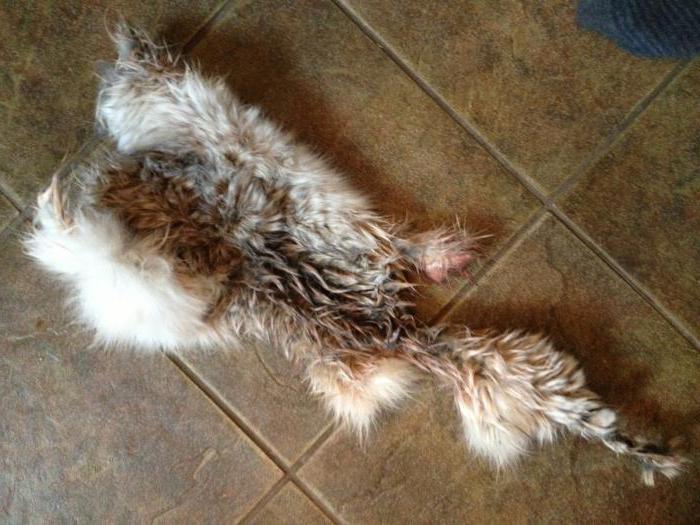
The solution can be supplemented with a decoction of eucalyptus, oak or willow leaves, using a proportion of 50 milliliters per 1 liter of water. If you wish, you can use the technology, which involves the use of washing powder, so that after the completion of the procedure it is not required to wash the material. For prolonged storage of skins, the solution should be changed every 12 hours.
Coating process
If you will make rabbit skins at home, it is recommended to familiarize yourself with the photo in advance. They will allow you to avoid mistakes. After soaking is complete, rinsing can be started using water. The liquid should drain, only after that it is possible to begin pulling the material onto the deck. The fur surface should be facing inward. Using a blunt knife, you should scrape them along the ridge, moving along the tail. Side zones need to be processed, heading from the ridge.
Quite often, breeders wonder how to make rabbit skins at home. Oiling is made at this stage. It involves removing the film from meat and residual fat. Mezdrit can be the reverse side of the knife blade or use a steel brush.
Degreasing
In order to degrease the skins, you should use the washing method in a solution of toilet soap. It must be applied in an amount of 25 grams per 1 liter of water. An effective alternative to soap is shampoo. You can use the powder "Lotus". It must be added as much as you usually use for washing. The main condition is that the composition should not contain bleach.
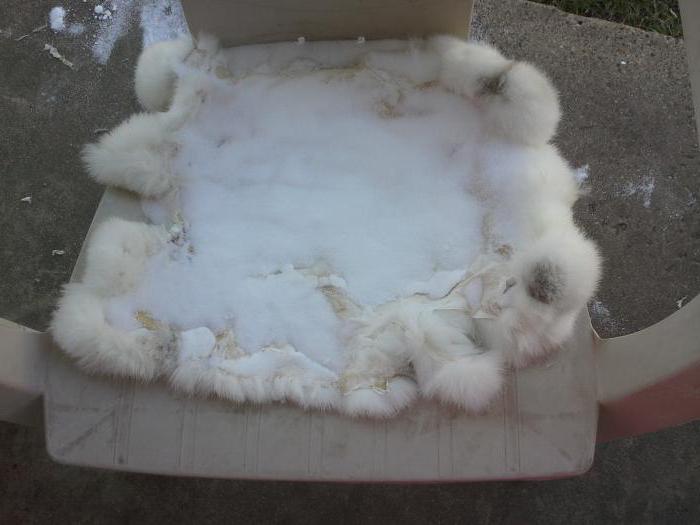
After completing this procedure, the material is suspended to drain water, then the mezdra must be wiped with a dry rag. Water must be thoroughly removed, as excess fluid can harm further operations. Before making rabbit skins at home, pickling or pickling should be studied in advance.
Fermentation Procedure
This method is a classic method of dressing. Thanks to this procedure, high skin strength can be achieved. The load during tearing is several times greater compared to pickling. The disadvantage of this technique is the rather lengthy processing and high consumption of flour. Using a glass container, stir a mixture of 200 grams of oat or rye flour with one liter of hot water. The solution must be brought to a homogeneous mass by adding 7 g of yeast, 30 g of sodium chloride and 0.5 g of baking soda.
Fermentation Guidelines
The above solution should be used in an amount of 3 liters of composition per 1 kilogram of skins. The latter are placed in the cooled composition of the mezdra out. Within two days, swelling and souring will occur under conditions of high acidity. The skins should be turned over, mixing jelly. This is necessary so that the solution does not rot, and a film does not form on top.After a few days, a white coating should appear on the surface of the mezra. The solution will be identical in smell to bread. This suggests that the procedure should be completed.
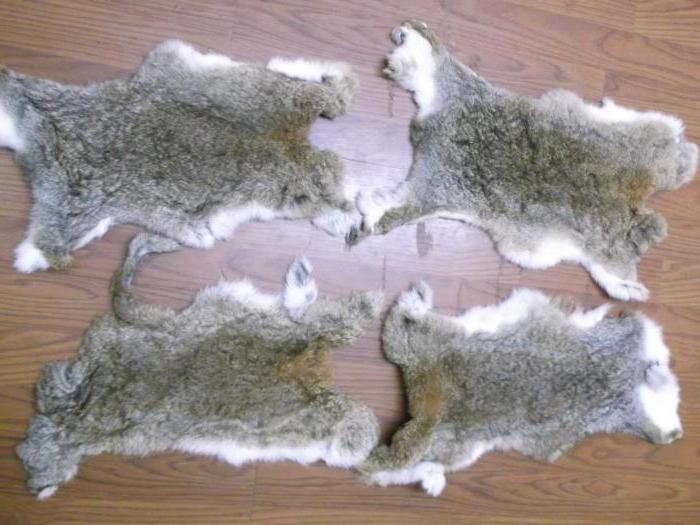
Each breeder should know how to make rabbit skins at home (the steps are described in the article). It is important not to overexpose the workpieces in the solution, as they can be left without hair. After completion of the process, you can proceed to tanning.
Pickling Tips
This stage involves the preparation of an acetic picel, which consists of 50 grams of sodium chloride, acetic acid in a volume of 12 milliliters and water heated to 35 degrees. Concentrated acetic acid can be replaced with 70 percent vinegar, using it in an amount of 60 ml per liter of water. Salt must be taken in a smaller volume - 30 grams, and water is used in an amount of 940 milliliters. If you plan to prepare the composition from 12 percent table vinegar, then the latter will need 350 milliliters. The volume of water is reduced to 650 ml.
Using 9 percent table vinegar, add 466 milliliters of vinegar and 533 grams of water. At the same time, it will be possible to obtain a 4.2% pickle. Some experts believe that a three percent solution is excellent for this, which contains 250 milliliters of the essence of table vinegar. The latter should have a 12 percent concentration. With this ratio of ingredients, you need 1 liter of water.
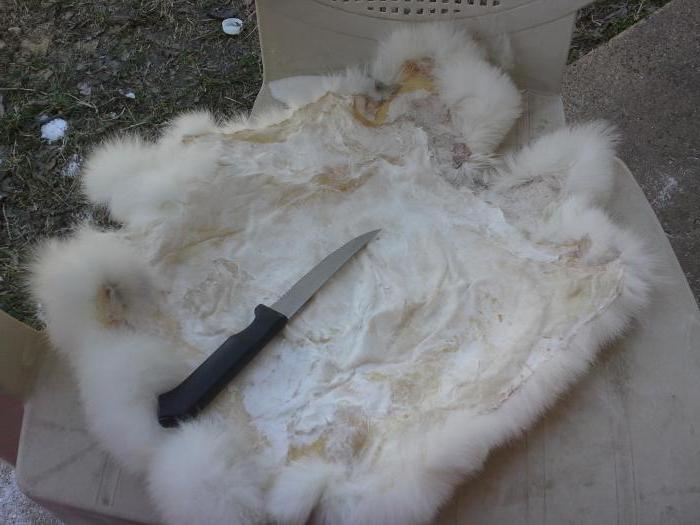
So, we are considering how to make rabbit skins at home. Washing preforms has been described above. Now in the solution for the pickel it is necessary to withstand the material for two days, often enough mixing it. The end of pickling should be done by pinching. To do this, hair is plucked in the groin area: if they depart easily, then the process can be considered completed. The material is removed from the composition, twisted to rid the skin of the solution. After that, the workpiece is transferred to a picate sulfate, which is prepared from 50 grams of table salt, a liter of water and 5 milliliters of concentrated acid. After 12 hours, the skins can be removed, squeezed, stacked, fur facing up. The load is stacked on top. In this position, the stacks are left for 48 hours. During this time, they will ripen.
Carrying out neutralization and tanning
If you are thinking about how to make rabbit skins at home, the process described in the article will help you cope with the work. The next step is the neutralization, which provides for the exposure of the material in a soda solution in the amount of 1.5 kilograms per liter of water. Then you can do tanning, which is divided into two types - chrome and tannid. For chrome tanning, you will need 1 liter of water and 7 grams of chrome alum. The ingredients are mixed, and then 60 grams of sodium chloride is added.
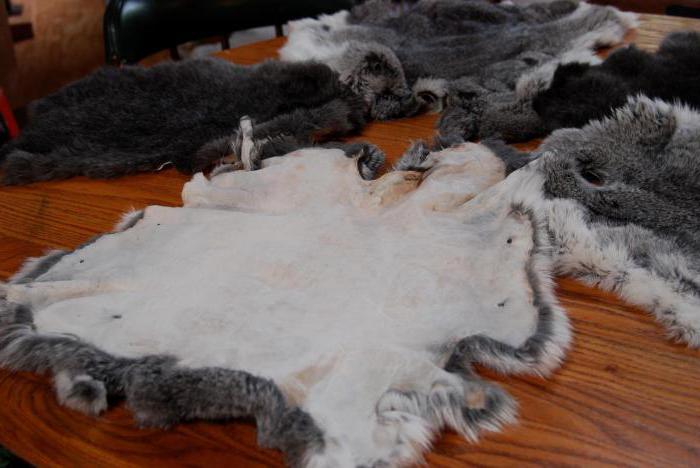
The skins are aged in such a solution during the day, the composition must be constantly stirred. The second type of tanning is carried out in a decoction of oak bark, for this you should use dishes filled with small branches. Water is added to the container, and after the cup is set on fire and boiled for half an hour. To the resulting solution add 50 grams of table salt, after which the composition cools. It contains rabbit skins for 4 days. After the material is obtained, it is left under oppression for two days.








